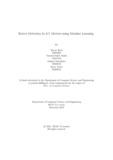| dc.contributor.advisor | Chakrabarty, Dr. Amitabha | |
| dc.contributor.author | Rouf, Shakir | |
| dc.contributor.author | Akash, Nazmus Sakib | |
| dc.contributor.author | Chowdhury, Amlan | |
| dc.contributor.author | Jahan, Sigma | |
| dc.date.accessioned | 2020-10-27T05:48:08Z | |
| dc.date.available | 2020-10-27T05:48:08Z | |
| dc.date.copyright | 2019 | |
| dc.date.issued | 2019-12 | |
| dc.identifier.other | ID: 16101104 | |
| dc.identifier.other | ID: 16101208 | |
| dc.identifier.other | ID: 16101042 | |
| dc.identifier.other | ID: 16301031 | |
| dc.identifier.uri | http://hdl.handle.net/10361/14069 | |
| dc.description | This thesis is submitted in partial fulfillment of the requirements for the degree of Bachelor of Science in Computer Science, 2019. | en_US |
| dc.description | Cataloged from PDF version of thesis. | |
| dc.description | Includes bibliographical references (pages 46-49). | |
| dc.description.abstract | Internet of Things (IoT) devices are a group of interconnected devices or machines that have the ability to transfer data over a network without the influence
of any external factor. The technology makes use of sensor nodes embedded into
everyday computing objects, which communicate in a wireless multi-hop fashion
to exchange data over a local network or the internet. With the rapid technological advancements taking place around the globe, the use of IoT devices has
also increased proportionately. Although the prevalence of IoT devices in human
lives has influenced the IoT manufacturers to make it cheap an accessible, but on
the other hand, the system provides minimal control with no substantial security
measures due to its prodigious application, which in turn makes it susceptible to
botnet attacks. Botnet is a network of interconnected malware contaminated IoT
devices, individually referred to as a bot. These bots are used as instruments of
malicious attack on a network of IoT devices which allows the group of hackers
(referred to as Botmaster) to perform distributed denial-of-service attack (DDoS),
data theft and spam by flooding the network with unnecessary information. As
a result, botnet detection has risen as an essential ingredient of network security.
In this paper, our motive is to use various Machine Learning algorithms to detect
botnet attacks and filter out the algorithm which will be most suitable and accurate to detect such attacks by comparing the derived outputs. | en_US |
| dc.description.statementofresponsibility | Shakir Rouf | |
| dc.description.statementofresponsibility | Nazmus Sakib Akash | |
| dc.description.statementofresponsibility | Amlan Chowdhury | |
| dc.description.statementofresponsibility | Sigma Jahan | |
| dc.format.extent | 49 pages | |
| dc.language.iso | en_US | en_US |
| dc.publisher | Brac University | en_US |
| dc.rights | Brac University theses are protected by copyright. They may be viewed from this source for any purpose, but reproduction or distribution in any format is prohibited without written permission. | |
| dc.subject | Botnet | en_US |
| dc.subject | DDoS (Distributed Denial of Service) | en_US |
| dc.subject | IoT (Internet of Things) | en_US |
| dc.subject | Machine Learning Classifiers | en_US |
| dc.title | Botnet detection In IoT devices using machine learning | en_US |
| dc.type | Thesis | en_US |
| dc.contributor.department | Department of Computer Science and Engineering, Brac University | |
| dc.description.degree | B. Computer Science | |

